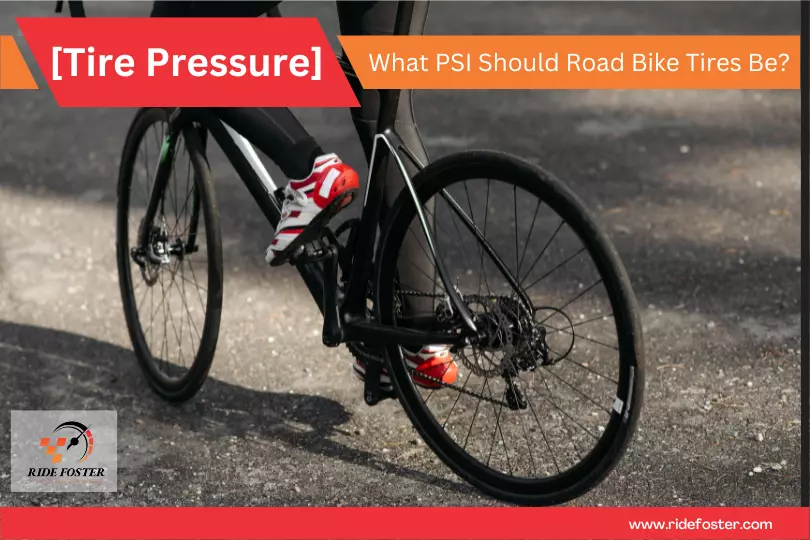Maintaining the correct tire pressure is crucial for any cyclist, but it is particularly important for road cyclists.
The right tire pressure can improve your performance, reduce the risk of flats, and ensure a comfortable ride.
However, determining the correct psi for your road bike tires can be challenging, as it depends on a variety of factors, such as your weight, bike type, and riding terrain.
In this article, we will examine the factors that influence the right psi for your road bike tires and provide you with practical tips on how to determine and maintain the correct tire pressure.
We will also discuss the impact of tire width on psi settings, as well as the recommended psi settings for different types of road bikes.
Whether you are a seasoned road cyclist or just starting out, this article will help you optimize your tire pressure for optimal performance and safety.
Table of Contents
- 1 Key Takeaways
- 2 The Importance of Tire Pressure for Road Cyclists
- 3 Factors That Influence the Right Psi for Your Road Bike Tires
- 4 How to Determine the Correct Tire Pressure for Your Weight and Bike Type
- 5 The Impact of Tire Width on Psi Settings
- 6 Adjusting Your Tire Pressure for Different Riding Terrain
- 7 Different Types of Road Bikes and Their Recommended Psi Settings
- 8 Tips for Maintaining Proper Tire Pressure for Optimal Performance and Safety
- 9 Frequently Asked Questions
- 9.1 Can I use the same psi settings for my road bike tires on different types of terrain?
- 9.2 What is the minimum and maximum psi range for road bike tires?
- 9.3 Can I use a tire pressure gauge to accurately measure my tire pressure?
- 9.4 How often should I check my tire pressure for optimal performance and safety?
- 9.5 Are there any specific tire brands that are known for their durability and performance?
- 10 Conclusion
Key Takeaways
- Determining the correct psi for road bike tires is challenging and depends on various factors such as tire pressure variability, weather conditions, terrain, load, weight distribution, and bike type.
- Wider tires require less air pressure than narrower ones for the same level of performance and offer improved stability, traction, and comfort.
- Adjusting tire pressure for different terrain can significantly improve riding experience and performance, with lower tire pressure preferred for off-road riding and higher tire pressure better for smoother roads and faster speeds.
- Proper tire pressure maintenance is crucial for optimal performance and safety, and regularly checking and maintaining tire pressure within the manufacturer’s recommended range is essential.
Checking tire pressure before every ride using a tire pressure gauge and adjusting accordingly is necessary, especially after any significant changes in temperature or altitude.
The Importance of Tire Pressure for Road Cyclists
Optimal tire pressure is a crucial factor for road cyclists as it affects their ride quality, handling, and overall performance.
The importance of inflation cannot be overstated, as it directly determines the amount of contact between the tire and the road surface.
This, in turn, affects the amount of grip that the tire can provide, which is essential for cornering, braking, and accelerating.
Inadequate inflation can lead to tire deformation, causing a larger contact patch and reducing the tire’s ability to hold the road.
This can result in a loss of control, especially during sharp turns or wet conditions.
The effects of underinflation are particularly detrimental to road cyclists, as they often ride at high speeds and require precision handling.
Underinflated tires not only reduce grip but also increase rolling resistance, making the ride more sluggish and less efficient.
This can lead to increased fatigue and reduced performance, as the cyclist has to work harder to maintain their speed.
Moreover, underinflated tires are more prone to punctures and cuts, as they are more susceptible to damage by sharp objects on the road.
Therefore, it is imperative for road cyclists to regularly check their tire pressure and maintain it within the manufacturer’s recommended range.
Factors That Influence the Right Psi for Your Road Bike Tires
Various factors play a significant role in determining the appropriate air pressure level for your road bike tires.
One of the most important factors is tire pressure variability.
This refers to the fluctuation of tire pressure caused by changes in temperature, altitude, and riding conditions.
As a general rule, road bike tires should be inflated to a pressure that allows for a smooth and efficient ride, while also ensuring adequate grip and control.
This means that the right psi for your road bike tires may vary depending on the specific conditions of your ride.
Another factor to consider when determining the appropriate psi for your road bike tires is weather conditions.
In cold weather, the air inside your tires will contract, causing a decrease in tire pressure.
Conversely, in hot weather, the air inside your tires will expand, causing an increase in tire pressure.
This means that you may need to adjust the psi of your tires depending on the temperature and weather conditions in which you will be riding.
Additionally, if you are riding in wet or slippery conditions, it is recommended that you lower your tire pressure slightly to improve traction and control on the road.
How to Determine the Correct Tire Pressure for Your Weight and Bike Type
One crucial consideration for determining the appropriate air pressure level for your bicycle’s tires is your weight and the type of bike you are riding.
The recommended tire pressure for a road bike can vary depending on the weight distribution of the rider and the bike.
The tire pressure gauge can provide an accurate measurement of the air pressure level in your tires.
To determine the correct tire pressure for your weight and bike type, you need to consider the load that your bike is carrying.
The load includes your weight, the weight of any accessories or gear you are carrying, and the weight of the bike itself.
You should also take into account the type of terrain you will be riding on.
For example, if you are riding on smooth, flat roads, you may want to use a higher tire pressure to reduce rolling resistance.
Conversely, if you are riding on rough terrain, you may want to use a lower tire pressure to provide more traction and absorb shocks.
The Impact of Tire Width on Psi Settings
The width of a tire can significantly impact the air pressure level needed for optimal performance.
As a general rule, wider tires require less air pressure compared to narrower ones to maintain the same level of performance.
This is because wider tires have a larger surface area in contact with the ground, which means that they can absorb more of the road’s irregularities without compromising their stability.
Moreover, wider tires offer more traction, which can improve the overall riding experience.
Effects of weather on tire pressure: Changes in temperature and humidity can affect tire pressure, as these factors can cause the air inside the tire to expand or contract.
Cyclists should check their tire pressure regularly, especially during extreme weather conditions, to ensure that their tires are inflated to the optimal level.
Benefits of using wider tires for road biking: Wider tires offer several benefits, including improved stability, better traction, and increased comfort.
They can also reduce the risk of punctures and make it easier to ride on rough terrain.
Cyclists who prioritize comfort and stability over speed and aerodynamics may benefit from using wider tires.
However, wider tires may not be suitable for all riders, and it is important to choose the right tire size based on personal preferences and riding style.
Adjusting Your Tire Pressure for Different Riding Terrain
Adjusting tire pressure based on the terrain can significantly improve a cyclist’s riding experience and overall performance.
Mountain biking techniques and downhill riding skills require different tire pressures for optimal performance.
In general, lower tire pressure is preferred for off-road riding to increase traction and absorb shocks from rough terrain.
Conversely, a higher tire pressure is better for smoother roads and faster speeds, providing less rolling resistance and better handling.
To help cyclists determine the ideal tire pressure for different terrain, the following table presents a general guide for tire pressure settings based on rider weight and tire width.
It is important to note that these are only general recommendations and riders may need to experiment with different tire pressures to find what works best for their individual preferences and riding styles.
| Rider Weight (lbs) | Tire Width (mm) | Rough Terrain (psi) | Smooth Roads (psi) |
|---|---|---|---|
| Up to 120 | 25-28 | 60-80 | 80-100 |
| 120-150 | 25-28 | 70-85 | 85-105 |
| 150-180 | 28-32 | 75-90 | 90-110 |
| Over 180 | 28-32 | 80-95 | 95-120 |
Adjusting tire pressure is an essential aspect of cycling that can enhance a rider’s experience and performance.
Cyclists should always consider the terrain they will be riding on and adjust their tire pressure accordingly.
Mountain biking techniques and downhill riding skills require a lower tire pressure for better traction and shock absorption, while a higher tire pressure is better for smoother roads and faster speeds.
Experimenting with different tire pressures is necessary to find the ideal setting that works for individual preferences and riding styles.
Different Types of Road Bikes and Their Recommended Psi Settings
Understanding the variations in recommended air pressure for different types of road bike tires can greatly affect the performance and comfort of a rider’s experience.
As a rider, it is important to know the different types of road bikes and their respective recommended psi settings to ensure optimal riding experience.
Generally, road bike tires are classified into two types: clincher and tubular.
Clincher tires are the most common type of road bike tires and are compatible with most road bike rims.
They usually have a recommended psi setting of 80-120 psi.
However, the recommended psi setting may vary depending on the rider’s weight, riding style, and the road conditions.
On the other hand, tubular tires are less common and are usually used by professional riders.
They are glued onto the rim and have a recommended psi setting of 100-130 psi.
The higher psi setting allows for better speed and control, but it also increases the risk of punctures.
Understanding the advantages of different psi settings for different types of road bike tires is essential in optimizing a rider’s experience.
Tips for Maintaining Proper Tire Pressure for Optimal Performance and Safety
Different types of road bikes have varying recommended PSI settings based on the bike’s weight, tire size, and intended use.
It is crucial to follow these guidelines to ensure optimal performance, safety, and longevity of your bike.
However, proper tire pressure maintenance goes beyond simply setting the correct PSI.
In this section, we will discuss the Benefits of nitrogen inflation and Checking tire pressure before every ride.
Nitrogen inflation is becoming increasingly popular among cyclists due to its numerous benefits.
Nitrogen molecules are larger than oxygen molecules, which means they escape less easily through tiny pores in the tire’s rubber.
This results in longer-lasting tire pressure, which translates to fewer flats and longer tire life.
Nitrogen also eliminates moisture, which can cause corrosion and rust on metal rims.
While nitrogen inflation may come at a higher cost, its benefits outweigh the extra expense.
Checking your tire pressure before every ride is a crucial aspect of proper tire maintenance.
Over time, even a small drop in tire pressure can lead to a significant decrease in performance and safety.
Use a tire pressure gauge to measure the PSI and adjust accordingly.
It is also essential to check your tire pressure after any significant changes in temperature or altitude.
Neglecting to maintain proper tire pressure not only affects your bike’s performance but also increases the risk of accidents and injuries.
Incorporating these tire pressure maintenance tips into your routine will ensure your bike is performing at its best and keep you safe on the road.
| Pros of Nitrogen Inflation | Cons of Nitrogen Inflation | Comparison to Regular Air |
|---|---|---|
| Longer-lasting tire pressure | Higher cost | Nitrogen molecules are larger than oxygen molecules, which means they escape less easily through tiny pores in the tire’s rubber, resulting in fewer flats and longer tire life |
| Eliminates moisture | May not be readily available | Eliminates moisture, which can cause corrosion and rust on metal rims |
| Improves fuel efficiency | Limited availability of nitrogen filling stations | Can improve fuel efficiency |
| Reduces tire oxidation | No significant performance advantage | No significant performance advantage |
Frequently Asked Questions
Can I use the same psi settings for my road bike tires on different types of terrain?
The same psi settings on a road bike tire may not provide optimal handling on different types of terrain.
Adjusting psi can improve handling over bumps and increase traction on wet surfaces.
Proper psi varies depending on terrain and rider preference.
What is the minimum and maximum psi range for road bike tires?
The recommended psi range for road bike tires varies based on weight and tire width.
It is important to adjust tire pressure for different weather conditions.
The minimum and maximum psi range is typically indicated on the tire sidewall.
Can I use a tire pressure gauge to accurately measure my tire pressure?
Measuring tire pressure accurately requires the use of a reliable tire pressure gauge.
Both digital and analog gauges can effectively measure pressure, but digital gauges tend to offer greater precision.
Different types of tire valves can also impact measurement accuracy, with some requiring specific adapters for accurate readings.
How often should I check my tire pressure for optimal performance and safety?
Regular tire pressure monitoring is crucial for optimal performance and safety.
Signs of low tire pressure include increased rolling resistance, reduced handling, and increased risk of punctures.
Checking tire pressure every 1-2 weeks is recommended.
Are there any specific tire brands that are known for their durability and performance?
When it comes to durability and performance, top-rated options for road bike tires include brands such as Continental, Michelin, and Vittoria.
Additionally, affordable choices like Schwalbe and Kenda offer reliable options for riders seeking value.
Conclusion
In conclusion, tire pressure is an essential aspect of road cycling that affects both performance and safety.
Determining the right psi setting for your road bike tires requires considering several factors, including your weight, bike type, tire width, and the terrain you will be riding on.
A tire pressure that is too low or too high can significantly impact your riding experience, leading to issues such as poor handling, increased rolling resistance, and an increased risk of flats.
To ensure optimal performance and safety, it is crucial to maintain proper tire pressure regularly.
This includes checking your tire pressure before every ride and adjusting it as necessary based on the factors mentioned above.
By doing so, you can maximize the comfort, efficiency, and speed of your road bike, and reduce the likelihood of accidents or mechanical failures while cycling.
See Related Link:
https://www.bicycling.com/repair/a20004232/how-to-achieve-the-perfect-bike-tire-pressure/







